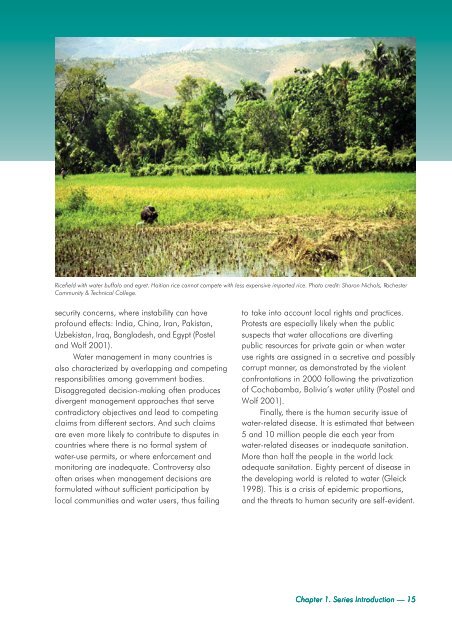Latin America; in English (pdf) - Transboundary Freshwater Dispute ...
Latin America; in English (pdf) - Transboundary Freshwater Dispute ...
Latin America; in English (pdf) - Transboundary Freshwater Dispute ...
Create successful ePaper yourself
Turn your PDF publications into a flip-book with our unique Google optimized e-Paper software.
Ricefield with water buffalo and egret. Haitian rice cannot compete with less expensive imported rice. Photo credit: Sharon Nichols, Rochester<br />
Community & Technical College.<br />
security concerns, where <strong>in</strong>stability can have<br />
profound effects: India, Ch<strong>in</strong>a, Iran, Pakistan,<br />
Uzbekistan, Iraq, Bangladesh, and Egypt (Postel<br />
and Wolf 2001).<br />
Water management <strong>in</strong> many countries is<br />
also characterized by overlapp<strong>in</strong>g and compet<strong>in</strong>g<br />
responsibilities among government bodies.<br />
Disaggregated decision-mak<strong>in</strong>g often produces<br />
divergent management approaches that serve<br />
contradictory objectives and lead to compet<strong>in</strong>g<br />
claims from different sectors. And such claims<br />
are even more likely to contribute to disputes <strong>in</strong><br />
countries where there is no formal system of<br />
water-use permits, or where enforcement and<br />
monitor<strong>in</strong>g are <strong>in</strong>adequate. Controversy also<br />
often arises when management decisions are<br />
formulated without sufficient participation by<br />
local communities and water users, thus fail<strong>in</strong>g<br />
to take <strong>in</strong>to account local rights and practices.<br />
Protests are especially likely when the public<br />
suspects that water allocations are divert<strong>in</strong>g<br />
public resources for private ga<strong>in</strong> or when water<br />
use rights are assigned <strong>in</strong> a secretive and possibly<br />
corrupt manner, as demonstrated by the violent<br />
confrontations <strong>in</strong> 2000 follow<strong>in</strong>g the privatization<br />
of Cochabamba, Bolivia’s water utility (Postel and<br />
Wolf 2001).<br />
F<strong>in</strong>ally, there is the human security issue of<br />
water-related disease. It is estimated that between<br />
5 and 10 million people die each year from<br />
water-related diseases or <strong>in</strong>adequate sanitation.<br />
More than half the people <strong>in</strong> the world lack<br />
adequate sanitation. Eighty percent of disease <strong>in</strong><br />
the develop<strong>in</strong>g world is related to water (Gleick<br />
1998). This is a crisis of epidemic proportions,<br />
and the threats to human security are self-evident.<br />
Chapter 1. Series Introduction — 15
















